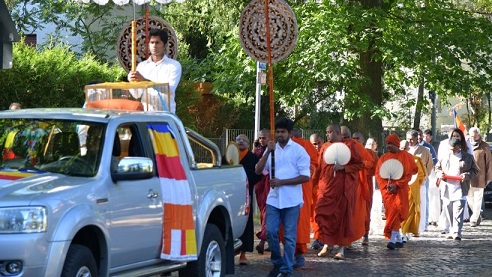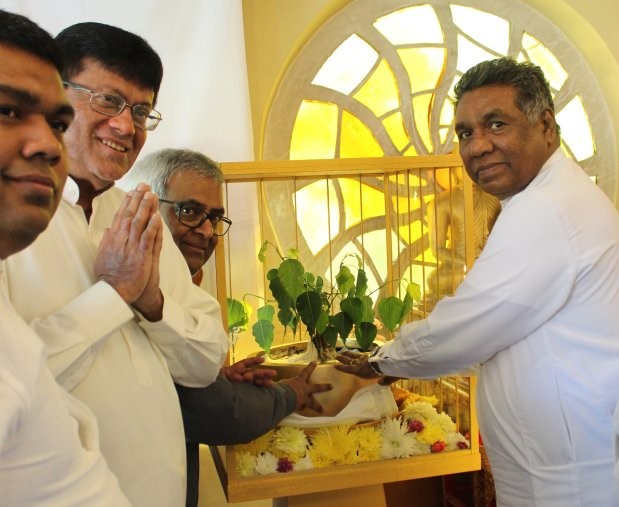Sri Lanka gives Buddhist House in Berlin – Frohnau Bodhi tree
Posted on October 21st, 2018
Courtesy Berliner Morgenpost
Sri Lanka’s Ambassador and nine monks presented the Buddhist house in Frohnau with an offshoot of the historic Bodhi tree.
Berlin
Quickly the glass of the yellow box is cleaned again and flowers draped in it. Children swing Buddhist flags. Women in white robes wear colorful flower baskets and sing devoutly. Nine monks in traditional orange robes wait beside the SUV. Swift step comes the Ambassador of Sri Lanka, HE Karunasena Hettiarachchi. In his arms, he carries the sacred relic in a golden bowl to the glass case and embeds the small bodhi tree on a cloth. The little sprout is protected by a white umbrella. Devoutly and quietly the solemn procession begins – from Zeltinger Platz in Frohnau it goes up the Edelhofdamm. Around 120 Buddhist pilgrims follow the procession to the Buddhist house.

Sprout comes from 2000 year old tree
It is a very special gift that Sri Lanka’s government has given to the Buddhist Center in Frohnau on Sunday. The Bodhi Tree is an offshoot of the holy Sri Maha Bodiya from Anuradhapura in Sri Lanka. According to tradition, Siddhartha Gautama is said to have experienced his awakening at 528 BC and to have become Buddha (“Awakened”). The Bodhi tree is therefore considered to be the root of the Buddhist faith in Sri Lanka and the oldest historically documented tree in the world.
Bodhi Tree – an attraction for thousands of Buddhist pilgrims
The Historic City of Anuradhapura was founded in the fourth century BC and then became a religious and political center. Around the Bodhi tree, many Buddhist monasteries and convents were built for the monks, stupas and temples were built. Anuradhapura was until the 11th century a thriving metropolis. After a lost war, the city was abandoned . For a long time the deserted city was hidden in the jungle and was forgotten.
Today, it is again a magnet for thousands of Buddhist pilgrims, as it still houses the sacred Bodhi tree, which is an offshoot of the sacred poplar-fig tree in Bodh Gaya, India. The plant is said to have reached the island of Ceylon (now Sri Lanka) in the 3rd century BC. A Buddhist missionary nun Sangamitta from India brought the Bo Sapling in a golden vessel and planted the Sapling where it can be seen as a fully grown tree even today.
Sprout must survive in the greenhouse
The Buddhists in Sri Lanka believe that as long as the mighty, gnarled and more than 2,000 years old Sri Maha Bodhi bears green leaves, Buddhism will also exist in Sri Lanka. Accordingly, the care of his offspring in Frohnau is also important.
Tissa Weeraratna, Administrator of the Buddhist House, is a little bit concerned. Because the German climate is not necessarily conducive to the tropical tree. “It’s important that it survives,” says Weeraratna. The Buddhist house is located on a nutrient-poor sandy hill; now comes the winter. “The tree remains in our library until we can build a greenhouse,” says the host. He does not care that it will soon rip the books off the library shelves with its branches. “The tree grows very slowly, maybe one and a half meters in ten years.”

Photo: The brothers Senaka Weeraratna (2nd from left) and Tissa Weeraratna (3rd from left) of the German Dharmaduta Society were handed the sacred Bodhi tree offshoot in the library of the Buddhist Haus in Frohnau by the Ambassador of Sri Lanka in Germany HE Karunasena Hettiarachchi (right)
Holy relic for Buddhists
While the festival is going on with many speeches in Sinhala, offering, meditation and eating together, Manel Böhm from Lichterfelde looks devoutly over to the tree. “This means a lot to us. The tree is part of our religion, and the Buddha sat gratefully for seven days in front of the tree for his awakening, “says the Sinhalese native. She also tries to follow Buddha’s path by collecting donations every month and then bringing sweets and school supplies to Sri Lanka.
First Buddhist Temple in Frohnau
During the ceremony, the German pioneer of Buddhism Dr. Paul Dahlke was gratefully acknowledged and commemorated. He founded the Buddhist House in 1924 in Frohnau. That is why the House is considered the oldest of its kind in Europe. During the Second World War, the Buddhist teachings were not allowed ( by the Nazi Regime). The debilitated House was almost demolished. But in 1957, the Founder and the then Secretary of the German Dharmaduta Society Asoka Weeraratna managed to acquire the land from the heirs of Dahlke. Frohnau henceforth housed the first Buddhist temple in Germany.
Buddha’s Teaching
Today the house is run by his nephew Tissa Weeraratna. Lay people can follow lectures and practice meditation with the help of a Dharma Teacher. Often the Buddhist Haus accommodates traveling monks.
“Buddha’s teaching is not difficult. Its realistic. It’s like chemistry or physics, says Weeraratna. The Buddhist doctrine is basically meant to give an insight into how to overcome one’s own painful existence. To attain this knowledge is the goal of Buddhist practice.
House always dependent on donations
Every day about 20 to 40 visitors – including school classes – try to come closer to “virtuous behavior” and to forge “noble friendships”. The house is financed by donations.
© Berliner Morgenpost 2018 – All rights reserved.
https://www.facebook.com/permalink.php?story_fbid=2109855632565090&id=100006220213882